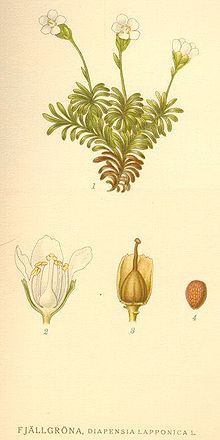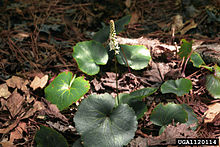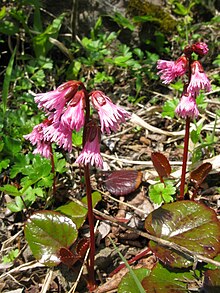Diapensiaceae
| Diapensiaceae | ||||||||||||
|---|---|---|---|---|---|---|---|---|---|---|---|---|

Diapensia lapponica in Greenland |
||||||||||||
| Systematics | ||||||||||||
|
||||||||||||
| Scientific name | ||||||||||||
| Diapensiaceae | ||||||||||||
| Lindl. |
The Diapensiaceae are a plant family in the order of the heather-like (Ericales) within the class of the flowering plants (Magnoliopsida). The taxa have a Holarctic distribution, with a focus on eastern Asia and the USA . Galax urceolata is used as an ornamental plant and its medicinal effects have been studied.
description
Vegetative characteristics

These species are mainly evergreen , perennial herbaceous plants or small subshrubs . They grow upright to creeping. Ecto- and endo- mycorrhiza are often present.
The alternate and spiral and often too many closely arranged leaves are stalked or sessile. The simple leaf blade is pinnate. The leaf margins are smooth, serrated or serrated. The leaves of Diapensia , Galax and some Shortia species turn reddish to purple or orange-bronze in autumn and winter due to anthocyanins, which is one reason why Galax leaves are used as cut green in floristry. Stipules are missing.
Generative characteristics
The flowers are solitary or in cape, racemose inflorescences . The hermaphrodite, radially symmetrical flowers are five-fold. There is a double perianth . The five petals are only fused at their base and the corolla lobes are spread out. There are one or two circles with five stamens each, up to five of which can be converted into staminodes ; if a stamen circle is missing then it is the inner one. The two-celled pollen grains have three or six apertures and are colpat, colporat or rugat. Most three, or rarely five carpels have become a top permanent ovary grown. The numerous ovules are anatropic or amphitropic. The stylus ends in an often three-lobed, rarely head-shaped or disc-shaped scar.
Loculicidal capsule fruits with three or seldom five-faced, many (10 to 30) seeds are formed. The small, cylindrical, brown seeds contain a large, fleshy endosperm and a straight or slightly curved embryo.
The base chromosome numbers are n = 6.
ingredients
The leaves of most species in particular accumulate large amounts of aluminum ions. They contain anthocyanins and flavonols .
Systematics and distribution
They have a Holarctic distribution. The distribution area is disjoint with emphasis in eastern Asia and the USA . They thrive in arctic to moderate climates, often in alpine altitudes.
The family name was first published in 1836 by John Lindley in An Introduction to the Natural System of Botany , 233. The type genus is Diapensia L. A synonym for Diapensiaceae is Galacaceae D.Don . In the past they were placed in the order of Diapensiales Engler & Gilg , today they belong to the Ericales . Within the Ericales, the Diapensiaceae are a sister group of the Styracaceae and these two families form a clade with the Symplocaceae .
The Diapensiaceae family includes five genera with around 12 to 15 species:
-
Berneuxia Decne. : With the only kind:
- Berneuxia thibetica Decne. (Syn .: Berneuxia yunnanensis H.L.Li , Shortia davidii Franchet ): It is a perennial herbaceous plant. They are found in moist fir forests, deciduous deciduous forests and bushes at altitudes of 1700 to 3500 m in the Chinese provinces of northwestern Guizhou , Sichuan , southeastern Xizang and northern Yunnan .
- Diapensia L .: With about five species in northern Europe, Asia and North America. They are half bushes.
-
Galax Sims : With the only kind:
- Bronze leaf ( Galax urceolata ( Poir. ) Brummitt , Syn .: Galax rotundifolia Pursh , Galax aphylla auct. Non L. , Pyrola urceolata Poir. ): It is an evergreen, perennial herbaceous plant. It occurs in shady places in forests, mainly in the Appalachians at altitudes up to 1500 m, in the southeastern United States from Massachusetts and New York south to northern Alabama .
-
Pyxidanthera Michx. : With two species in the southeastern United States. There are subshrubs:
- Pyxidanthera barbulata Michx.
- Pyxidanthera brevifolia Wells
- Shortia Torr. & A.Gray (Syn .: Schizocodon Sieb. & Zucc. , Sherwoodia House , Shortiopsis Hayata ): With six evergreen, perennial, herbaceous species in the southeastern USA (one species), in Japan (three species), on Taiwan and the Ryūkyū Islands (one type) and in the Chinese province of Yunnan (one type).
swell
- The family of Diapensiaceae in APWebsite. (Section description and systematics)
- The Diapensiaceae family at DELTA by L. Watson & MJ Dallwitz. (Section description)
- Haining Qin & Bruce Bartholomew: Diapensiaceae in the Flora of China , Volume 14, p. 235: Online. (Section description)
- Guy L. Nesom: Diapensiaceae in the Flora of North America , Volume 8, 2009, p. 332: Online. (Section description and systematics)
- Kristina Rönbloma & Arne A. Anderberg: Phylogeny of Diapensiaceae Based on Molecular Data and Morphology , in Systematic Botany , 27 (2), 2002, pp. 383-395: Online.
Individual evidence
- ↑ Entry in Plants for a Future. (English)
- ↑ Diapensiaceae in the Germplasm Resources Information Network (GRIN), USDA , ARS , National Genetic Resources Program. National Germplasm Resources Laboratory, Beltsville, Maryland.
- ^ PJ Scott: Diapensiaceae. In: Klaus Kubitzki (Ed.): The Families and Genera of Vascular Plants - Volume VI - Flowering Plants - Dicotyledons - Celastrales, Oxalidales, Rosales, Cornales, Ericales , 2004, pp. 117–121, ISBN 978-3-540- 06512-8
- ↑ Bruce A. Sorrie, Alan S. Weakley, Guy L. Nesom: Pyxidanthera in der Flora of North America , Volume 8, 2009, p. 336: Online.



